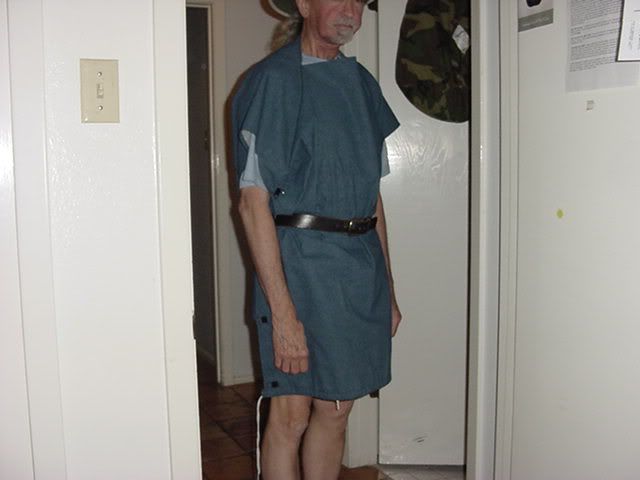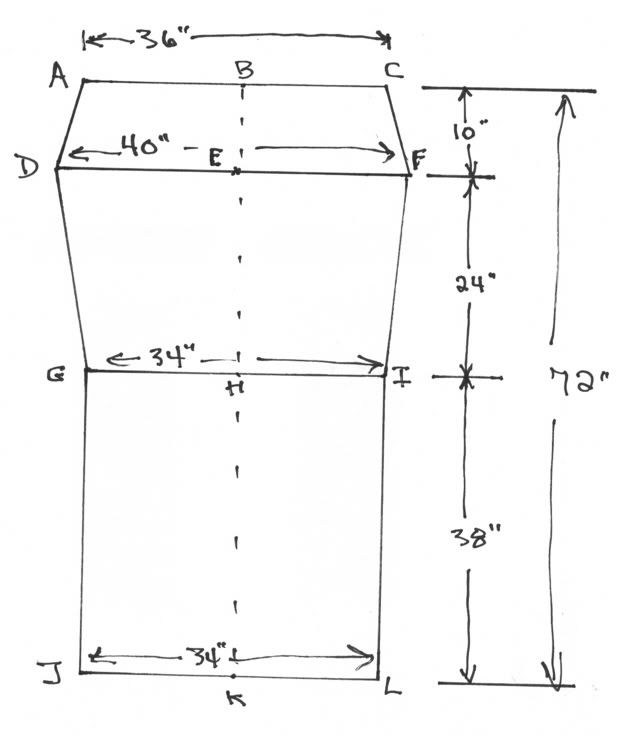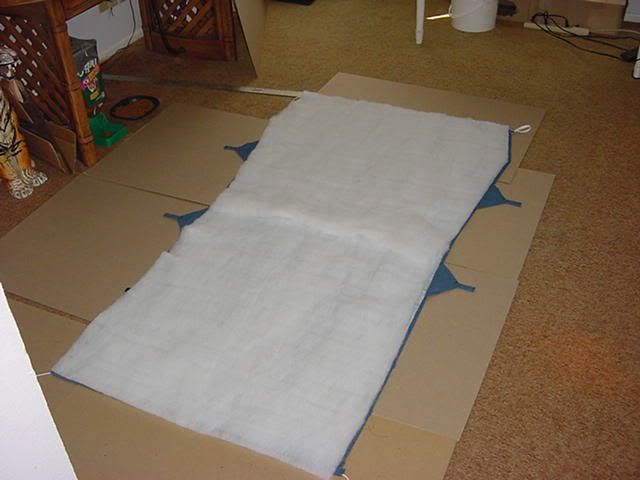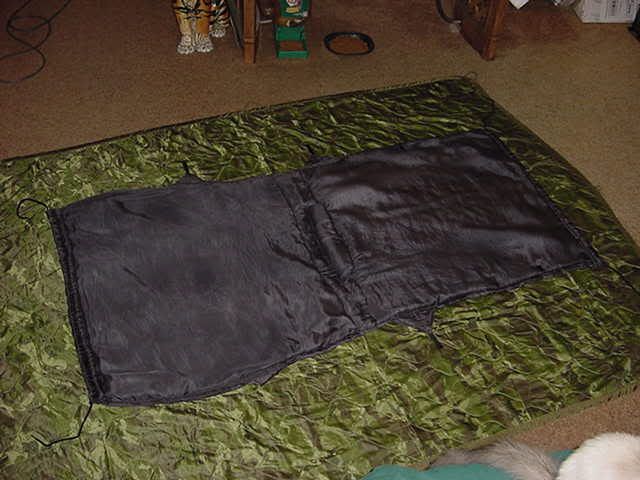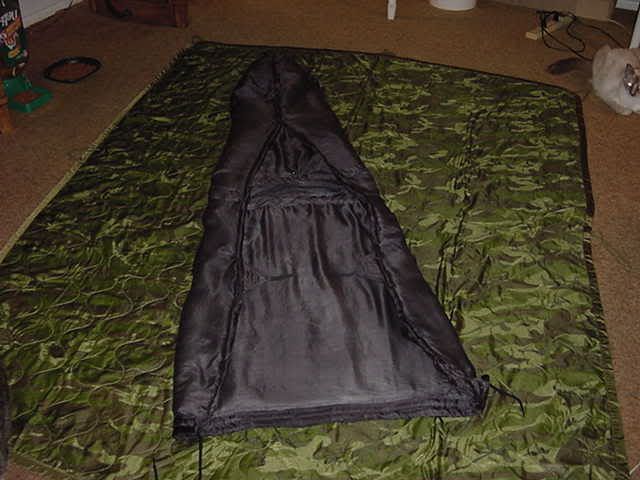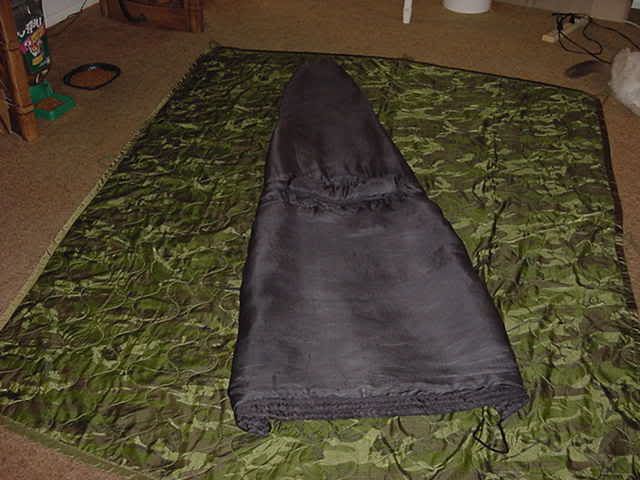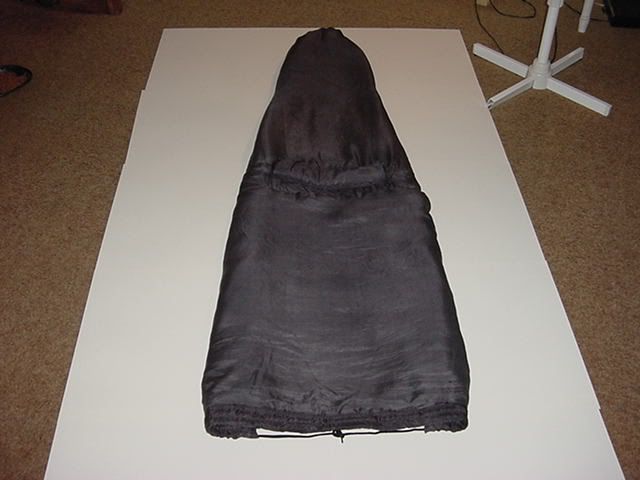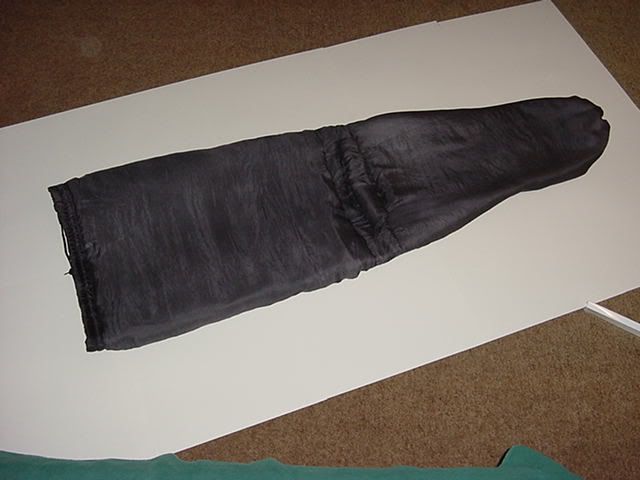Topic
7 ounce Polarguard-Delta Quilt
Forum Posting
A Membership is required to post in the forums. Login or become a member to post in the member forums!
Home › Forums › Gear Forums › Make Your Own Gear › 7 ounce Polarguard-Delta Quilt
- This topic is empty.
-
AuthorPosts
-
Aug 30, 2006 at 12:21 am #1361991
Hi Mark,
Thanks for the comments.
As for the triangular base things, yes I hope and how about when I wear the quilt as a garment?
If this works where do I count the weight?

 Aug 30, 2006 at 1:19 am #1361992
Aug 30, 2006 at 1:19 am #1361992Bill,
Maybe you should call this your “skin-out-weight-only” hike instead of crazy light. Since you’ll be waring most or all your gear all you need is add some pocket for some misc. items and off you go.
Good luck and i’ll keep reading your amazing posts.
Eins
Aug 30, 2006 at 4:55 am #1361994BIll,
Like the look…seem as minimal as possible….How do you plan to close the “No Sniveller” style head hole…Recommend Omni tape over regular velcro…Holds great…less scratchy…won’t pick up lint etc like the regular stuff…you can find it in sewing stores in 3/4 inch thickness… It will be called No Snag velcro and cost about $5 for a 36 inch length….Be sure to triple sew the ends as any velcro has a way of coming loose from one pass of regular stitching.
Pan
Aug 30, 2006 at 6:33 am #1361995Oh Jack,
To imply that every hole cut in a piece of fabric to allow your head to go through it is a “no sniveller” style head hole is a bit to much. Ponchos have been around longer than you have.
The rest of your comments bag to insult my intelligences.
Aug 30, 2006 at 7:14 am #1361998Einstein X
This is a follow-up on a few ideas from several years ago. How to use a “Great Kilt” as a start point for several different things used for hiking. Those ideas and drawings have been waiting a long time for the right time and place to get made.
Since we divide what we “wear” from what we “pack” the fastest way to drop weight is to be able to “wear it” during the day and use it in a different form “at night”. From the first piece of gear I made I have tried find a way to use it for more than one thing. I have talked for several years about moving my insulation from one item to another to save weight. I did this first with my home made Poly-Tube Down Air Mattress (DAM). I packed my Down in silk tubes that I refer to as baffles and could slide them in and out of the Poly-Tubes. That way I could use the Down baffles in other things when they were not being used for my DAM.
This is not an attempt to play games with weight as for a sub (what-ever) gear list, just a way to make every ounce count. We do divide our weight into different categories and I will list things that can be worn as just that. Most people don’t sleep naked so some clothing is used to help keep us warm at night anyway.
And it is fun to push the envelop.
Aug 30, 2006 at 7:41 am #1362001Hi Bill,
I’ve been enjoying seeing the pictures of your creations. I’m a quilt user myself and like your design, it looks very clever, especially its multi use aspect.
1. What is the width of your quilt?
2. I notice you are using some kind of white ribbon in place of cord at the head and foot ends. I think I recall seeing you use something similar in place of guylines for shelters. Are these possibly from cuben material? They appear like they are very light.
Cheers
Dan
Aug 30, 2006 at 8:37 am #1362004Bill,
No intent to insult…In fact, I believe you to be among the most, if not the most, forward thinking of the gear creators working on ultralight ideas.
While serapes have certainly been around for centuries, I don’t know of an insulated quilt or bag that incorporated the resealable head hole in the middle before the No Sniveller… Which, FTR, was a design request by Sgt Rock in a survey on under qulit designs almost 3 years ago on Whiteblaze.net.
Also while I recognise that you are probably fully aware of the nomenclature, location and costs of “no snag velcro”, I am also aware that frequently this forum generates second and third order questions by monitoring readers on the sounces, cost etc. This data was include for general info as I’ve found that it heads off extra questions/posts.
Good luck on your project…it is interesting work
Pan
Aug 30, 2006 at 10:16 am #1362014Jack,
Speaking as one who is just getting his feet wet in MYOG, I for one, appreciate any and all details on materials that are effective as well as where to procure them.
While we may address our posts to a particular person, sometimes for clarity of following “branching” threads, this is a public forum and I view it as an open classroom where I am being educated!
Thanks for including the details.
Also, your JRB inovations have made me a happier camper.
Aug 30, 2006 at 11:19 am #1362018Daniel asked:
Q – 1. What is the width of your quilt?Q – 2. I notice you are using some kind of white ribbon in place of cord at the head and foot ends.
Hi Daniel:
A – 1. I don’t have a CAD program but I really like what they are doing on the Tarp Design Thread. This might work.A 18″ B 18″ C
10″
D 20″ E 20″ F
24″
G 24″ H 24″ I
38″
J 17″ K 17″ L
This didn’t work very well. The 10″ needs to be under “B”. The 24″ needs to be under “E”. The number 38″ needs to be under “H”.
B to E to H to K is the Quilt center line and 72″ total.
A – 2. The white cord you see is a shoe lace that I used for the Prototype. The real Quilt will be some kind of light cord. I have a bunch of different kinds and will pick what ever is lightest and the color goes with the Gold-Yellow of the Pertex Quantum.
Aug 30, 2006 at 2:14 pm #1362023You mean something like this?
 Aug 30, 2006 at 4:41 pm #1362036
Aug 30, 2006 at 4:41 pm #1362036Mark, Thanks but in looking at your work I see that I listed one or more? numbers wrong. I did this drawing and scanned it.
 Aug 30, 2006 at 4:49 pm #1362037
Aug 30, 2006 at 4:49 pm #1362037Cutting “My Precious” :
Well that part went easy.


 Aug 30, 2006 at 6:45 pm #1362042
Aug 30, 2006 at 6:45 pm #1362042Very interesting thread regarding Climashield XP and Polarguard Delta. I am the Sales Director for both Polarguard and Climashield. Beyond a doubt XP is lighter than Delta. Standard testing protocol for basis weight is to weigh a piece 36″ x 36″. This weight in ounces gives the ounces per square yard of the batting. Regarding temperature ratings, for a given ounce per square yard XP will have a better temperature rating than Delta (~7%). The advantage is you can get a given temperature rating at a lower weight with XP versus Delta. However, Delta will have a higher loft than XP for a given basis weight. We could discuss theory throughout eternity in regards to the impact of loft on temperature rating. Bottom line is that this is a multi-variant optimization in terms of thermodynamic mechanisms (conductive, convective and radiative heat transfer mechanisms). Also, the true temperature rating is highly contingent upon bag/quilt/garment construction as well as shell and lining materials. There’s a lot of science involved but it’s still mainly an art. Both products, XP and Delta, are exceptional synthetic insualations and from my perspective the best two on the market today. Both are continuous filament so the durability is unsurpassed and even after numerous uses, launderings or prolonged storage they will recover and perform as well as the first time! If you are looking for ultralight weight synthetics we are currently working on a new product, Climashield Combat, that will become available in weights as low as 2.0 ounces per square yard. Good luck with all your efforts!
Aug 30, 2006 at 6:57 pm #1362043An insulating fabric weighing in at 2 oz/sq.yd. could bring quilts down into the sub 6 oz. range.
And we heard it straight from the horses mouth. It’s good to know we represent a slice of the community worthy of personal announcements and descriptions of a product from the (major) manufacturers themselves. The cottage manufactures walk amongst us daily of course.
Aug 30, 2006 at 7:58 pm #1362049It sure was nice seeing Brian’s comments. I have talked to Brian on the phone several times. He was very nice and took a lot of his time explaining the merits of both types of insulation. I hope to make a number of insulated items out of both the PG-Delta and the Climashield XP.
The best part of all this is that Climashield XP is available in amounts of a yard or more from Thru-Hiker.com. It also is nice to see that Ryan thinks he will have some Polarguard Delta available for MYOG folks this fall.
Aug 31, 2006 at 8:15 pm #1362142Bill-You and Brian were very polite to not rub it in that I had miscalculated the Polarguard Delta clo/oz value in an earlier thread… thank you for the education and the courtesy! You and Brian are both great assets on this forum.
Now for the controversial part <grin>.
Insulation clo/oz % loft when wet
Polarguard Delta .68 -40
Primaloft Sport .74 -11
Climashield XP .77 -??
Primaloft One .84 -00500 fill down 4.5 -60
800 fill down 2.5 -60Would you investigate a DIY source for Primaloft One? It would be the optimal solution for wet environments. Brian’s counterpart for Primaloft is Arnie Liati in the Primaloft Issaquah, WA office.
Would you let us know what quilt weight you could achieve using 800 fill down for your quilt? It is available from multiple sources and has a much better clo/oz value for dry environments.
My experience with synthetic bags is that I get about a 40% reduction in loft after one season’s use and then they stabilize at that loft. The temperature rating drops and stabilizes accordingly. I haven’t experienced more than 10% degradation in my down bags after multiple years of use. No one on the BPL forums has ever compared the loft degradation history between various synthetics. Would you monitor the loft degradation with your quilt experiments?
From your conversations with the Polarguard folks do you know what the Climashield XP loft reduction is when wet?
You continue to amaze me at the way you think outside the box to innovate. This area is ripe for someone to shake it up with some new ideas.
Sep 2, 2006 at 7:44 am #1362233Hi Richard,
When the question of Clo?? first came up back in June with the thread (Climashield non-siliconized, polyester continuous filament insulation claims highest Clo/Kg
You were the only person that even tried to explain what it means and how we might use that term/information. Whatever the results of your effort it was your action at time that has gotten us to here. You provided me a lead that allowed me to find and talk to Brian at Western Nonwovens.
So where are we now:
– I/we-all should know a lot more about CLO and have a planning guide – of sorts – for synthetic insulation vs temperature ranges.
– I think we know a lot more about Climashield XP and Polarguard Delta.
– We can buy Climashield HL and XP and that there are a couple of new insulations coming in the Climashield line.
– We know that there is a good chance that Polarguard Delta may be available in small amounts in a few months.
– We have Brian at Western Nonwovens contributing his knowledge to our efforts.
– And others.None of this would have happened without your input back in June.
Sep 4, 2006 at 11:03 pm #1362378I funny thing happened on the way to my 7 oz Polarguard Delta Quilt.
Once I cut the Polarguard Delta to the shape of my Quilt I put it on my scale. My planned for weight was 3.69 ounces. My 1.94 sq yards of Polarguard Delta weighed 4.29 ounces. The center part of the insulation was thicker and looked like somewhere in the process it may have lifted some insulation from the layer above or below it when it was made. Beyond that I have no real idea. The good news is that if I use this piece of Delta my per square yard weight is 2.21 ounces. This times the Delta Clo of .68 gives me a number of 1.503 (inches or what ever). That would make the Quilt warmer than planned for by a small amount. If I was using Down in the Quilt and had a loft of 1.5″ I would say it would be good somewhere between 40 and 50 degrees (F).
I spent the next several hours crunching the numbers. I even tried a smaller Quilt size. I made a full size cloth prototype. It was sized to come up only to my arm pits. It did that OK but I didn’t think it would work for me.
In all my number crunching the only material I have that would still get me close to the 7 ounce mark was some of my light silk. Using 4.5 mm silk (0.57 oz per sq yard) for both the top and bottom I would be over 7 oz by a .5 to .75 of an ounce. That assumed no other surprises.
I finished the Quilt a little while ago. It weighs 7.65 ounces. Accounting for the extra 0.60 ounces of extra PG – Delta I should be happy. I will have a Quilt that will be warmer by a factor of 1.5 over 1.3. It fits me snug with the foot box closed. In my Hammock the foot box as well as the complete right side of the Quilt will be connected to the right side of the Hammock. I think the Quilt will be OK on the ground as a sleep on my back. I got in it to see how the fit was and began to get warm fast. It is 74 degrees in my bedroom.



I really learned a lot about sewing a Quilt. I think I over sewed much more than might have been necessary. I believe I could now make another Quilt from the same pattern and save some weight with less sewing. I should say sewing the Quilt differently.
I did design this Quilt so I can wear it and for a SUL Gear List for cool weather it should do double duty. I think the extra sewing for the head hole accounted for a little of the extra weight.
Weight Breakout:
PG-Delta – 4.29 oz
Silk for Shell and Liner – 2.22 0z
Other – 1.14 – ozCurrent Total Weigh – 7.65 oz
Sep 5, 2006 at 7:37 am #1362400I [sic] funny thing happened on the way to my 7 oz Polarguard Delta Quilt.
Bill, I’m going to try real hard not to say here, “not that funny considering your ridiculously small sample size”. Dang. Too late. <grin>
Sep 5, 2006 at 9:20 am #1362410Charles,
I don’t disagree with you about the sample size but I only had a 5 yard piece of the PG-D and that is a little bulky to sit on my scale. I didn’t want to fold or roll up a larger piece that small as I had never worked with this stuff before and it had been shipped without ever being vacuum packed. What I have learned is that the PG-D recovers fast from compression. This was my first Synthetic Insulation MYOG Project and like any “first time” I am really happy it is finished. The next ones will be much easier.I have only worked with Down in the past and that was easy to figure the finial weight of.
When I make the next Quilt I will weigh all the necessary insulation first and see what it weighs. Then decide what to use as Shell and Liner material.
How do you suggest sampling the weight of a 60 yard roll?
Sep 5, 2006 at 11:30 am #1362419> How do you suggest sampling the weight of a 60 yard roll?
Bill, you could take it to the Post Office, weigh it on a package scale and then divide by 60.
Sep 5, 2006 at 11:46 am #1362422Hi Sam,
Thanks for you comment – now all I need is the 60 yard roll. Do you have any idea how big a 60 yard roll by 60″ wide insulation might be?Some better pictures:



 Sep 5, 2006 at 6:42 pm #1362468
Sep 5, 2006 at 6:42 pm #1362468Bill maybe a truck stop weigh station would be a better bet.
It’s hard to tell from the photos, Bill, but is the footbox comprised soley of the tie mechanism at the bottom or is that a piece of Velcro (or similar) about a foot up from the end as well?
Have you tested this in a draft yet? How about with your kilt/mat/party-ballon thingy? Are you going to be able to create a moderately-hermetic seal against the night air?
Looks great so far.
Sep 5, 2006 at 8:54 pm #1362480Sam,
First let me say I really hate Velcro and “almost” never use it.
The foot box is connect with three pairs of hook like things. Then if you see the triangle looking things sewn into the side seams – they will connect to the ones on the other side of the Quilt and hold the Quilt more or less to a sleeping pad. In my case to my Kilt/CheerStic Air Pad “thingy” or what ever I happen to use. The Quilt will also be used in my Spreader Bar Hammock and the Hook things for the foot box will connect the foot end of the Quilt to the foot end of my Hammock. The side triangle things will connect also to the sides of my Hammock. I was going to work that out this afternoon in my backyard but we had a little rain.
I have a BMW Vapr Bivy Sack (Pertex Quantum) at about 6.5 ounces that I think I can put this all inside if I need to for “a moderately-hermetic seal against the night air”. I haven’t tried this yet and if I don’t have enough room I will make my own bivy out of Cuben and Pertex Quantum. I will test this in my backyard and then again in Georgia next month to see how it works in cooler weather. I will take and post some pictures of this all together.
The end game here is a Sub 2-lb, Sub 3-lb, Sub 4-lb set of gear lists. Heavier when cooler – lighter when possible.
Sep 6, 2006 at 8:05 pm #1362542Howdy, howdy Bill! I read this whole forum just now and, maybe coming from a 13hr PCT funding day, missed what exactly Clo is. I know that all of you guys posting are intense MYOG men and could help a recent turncloak out. I have made 6 total Ray-Way kits this summer and only weighed everything after it was finished b/c I knew it would be less than I carried on the AT. I have since purchased material from Thru-hiker and Seattle Fabrics and refer to the MYOG forums to get ideas from all those who go before me in that area. I sleep really cold and am planning on taking my WM Versalite 10deg on the PCT ’07, but have made 2 quilts and would love to find a way to make something that would be lighter than my 2lb4oz 6’6″ WM bag. Do any of you think that it’s worth it?
-
AuthorPosts
- You must be logged in to reply to this topic.
Forum Posting
A Membership is required to post in the forums. Login or become a member to post in the member forums!
Our Community Posts are Moderated
Backpacking Light community posts are moderated and here to foster helpful and positive discussions about lightweight backpacking. Please be mindful of our values and boundaries and review our Community Guidelines prior to posting.
Get the Newsletter
Gear Research & Discovery Tools
- Browse our curated Gear Shop
- See the latest Gear Deals and Sales
- Our Recommendations
- Search for Gear on Sale with the Gear Finder
- Used Gear Swap
- Member Gear Reviews and BPL Gear Review Articles
- Browse by Gear Type or Brand.


